Main Content
Steve Yergeau, Sal Mangiafico, Jean Epiphan, Michele Bakacs, and Amy Rowe
The Earth Day, Every Day Team wanted to pause and reflect on the environmental issues and events that that we are grateful for this year (and every year!). If you would like to learn more about any of the topics mentioned, you can review any of the ‘Earth Day, Every Day’ webinars on wildlife, rain gardens, native plants, plastics, and volunteering at envirostewards.rutgers.edu/earth-day-every-day/.
I am thankful for the return of abundant bald eagles to New Jersey
Sal Mangiafico, Rutgers Cooperative Extension – Salem & Cumberland Counties
The first time I saw a bald eagle was in 1999 in Washington state. It was perched in a distant tree. I was very excited to see one in real life and took a photograph with my point-and-shoot film camera. The eagle ended up as a small white spot among the trees in the photograph, that I would point out to those willing to look at my photos.
By the time I moved to Salem County in 2009, I found that seeing bald eagles among the farm fields was common.
New Jersey Bald Eagle Project report
The NJDEP 2022 New Jersey Bald Eagle Project report is a wealth of information about where bald eagles are found in the state (NJDEP–FW, 2022). It lists eagle nests, and the number of hatches and fledges by nest site in the state.
It’s not known what the eagle population was in New Jersey before, say, 1930. Traditionally, eagles faced depredation due to concerns that they threatened game and livestock. It was estimated that there were more than 20 nesting pairs in the Delaware bay region of New Jersey in the 1950’s. The use of the pesticide DDT is blamed for the decline of bald eagles down to one nesting pair by 1970.
Now there are 267 monitored nesting sites in the state, and it is common to see eagles foraging in farm fields, over lakes, and perched in trees in state wildlife areas and along the roadside.
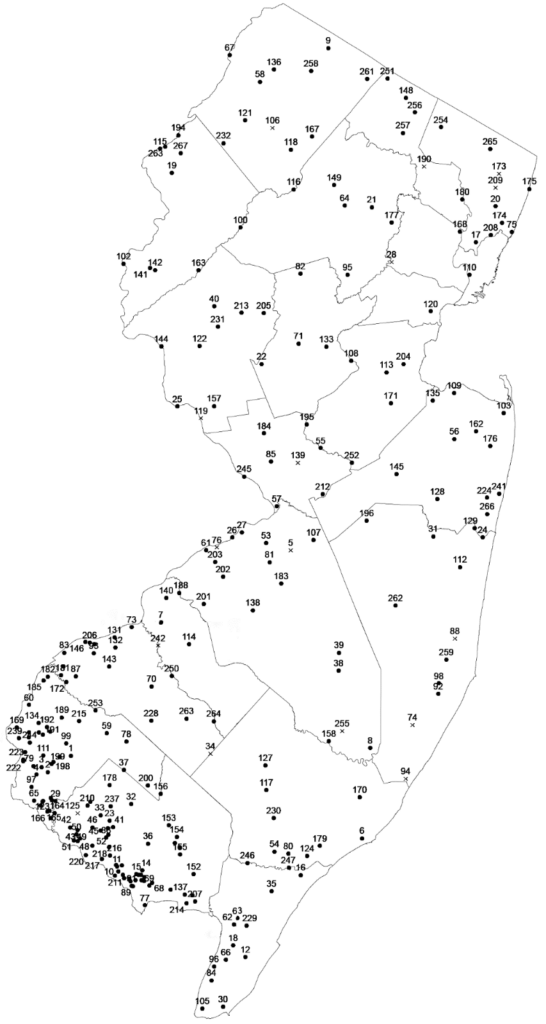
Map of active (black circle) and territorial (x) bald eagle nests in NJ in 2022. Numbers are site identification from the report. From NJDEP–FW (2022).

Number of bald eagle nests and young fledged in New Jersey, 1990–2022. Blue
bars=number of nests, and blue lines=number of young produced each year. From NJDEP–FW (2022).
Reference
[NJDEP–FW] New Jersey Department of Environmental Protection–Fish and Wildlife. 2022. New Jersey Bald Eagle Project, 2022. dep.nj.gov/wp-content/uploads/njfw/eglrpt22.pdf
I am thankful for native plant nurseries
Jean Epiphan, Rutgers Cooperative Extension – Morris County
Native plant nurseries are the principal purveyors of a primary commodity we need for successful land conservation and ecological restoration. Whether in a tiny forest, pollinator garden, or large wildlife reserve, native plants can sustain and restore natural heritage, habitat, and landscape health. I am thankful for native plant nurseries as they grow and provide the ideal native plant options we need for our landscapes today and into the future.
Native plants and natural plant communities are vital to the health of our ecosystems; they provide critical habitat and sustain resources for all levels of life from beneficial microbes to insects to birds, and larger wildlife. Native plants are the foundation of terrestrial ecosystems. However, severe losses of natural habitat in our developed state threaten environmental health and biodiversity. The best way our society can lessen our footprint, restore nature and its invaluable ecological benefits, is by incorporating native plants back into our landscapes. The nurseries that grow and sell native plants are truly givers of life and I am immensely grateful for them.
Resources
- The Native Plant Society of New Jersey’s Where to Buy Natives Listing. npsnj.org/native-plants/where-to-buy-natives/
- Jersey-Friendly Yards, Where to Buy Native Plants Listing. www.jerseyyards.org/jersey-friendly-plants/where-to-buy-native-plants/
- ‘May Native Plants Be With You!’ Earth Day Every Day newsletter article by Michele Bakacs. salem.njaes.rutgers.edu/2022/05/01/may-native-plants-be-with-you/
- ‘Incorporating Native Plants in Your Residential Landscape” fact sheet by Deborah Pinto and Meredith Melendez. njaes.rutgers.edu/fs1140/
- Why Native Plants Matter. www.audubon.org/content/why-native-plants-matter
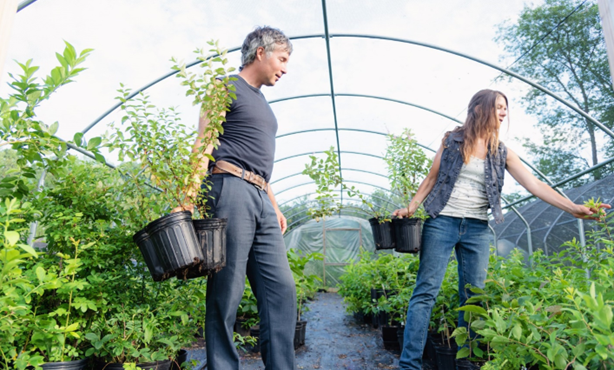
Proprietors and operators of the native plant nursery, Wild Ridge Plants, among their locally native shrubs for sale. Photo Credit: Cari Ellen Hermann.
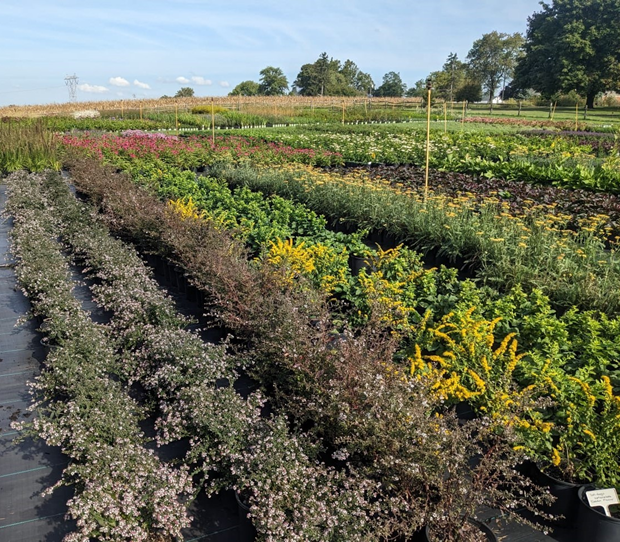
Sunset Farmstead’s native perennial stock blooming in autumn. Photo Credit: Carrie Stanker.
I am thankful for rain gardens…and the people that maintain them so they function properly
Michele Bakacs, Rutgers Cooperative Extension – Middlesex & Union Counties
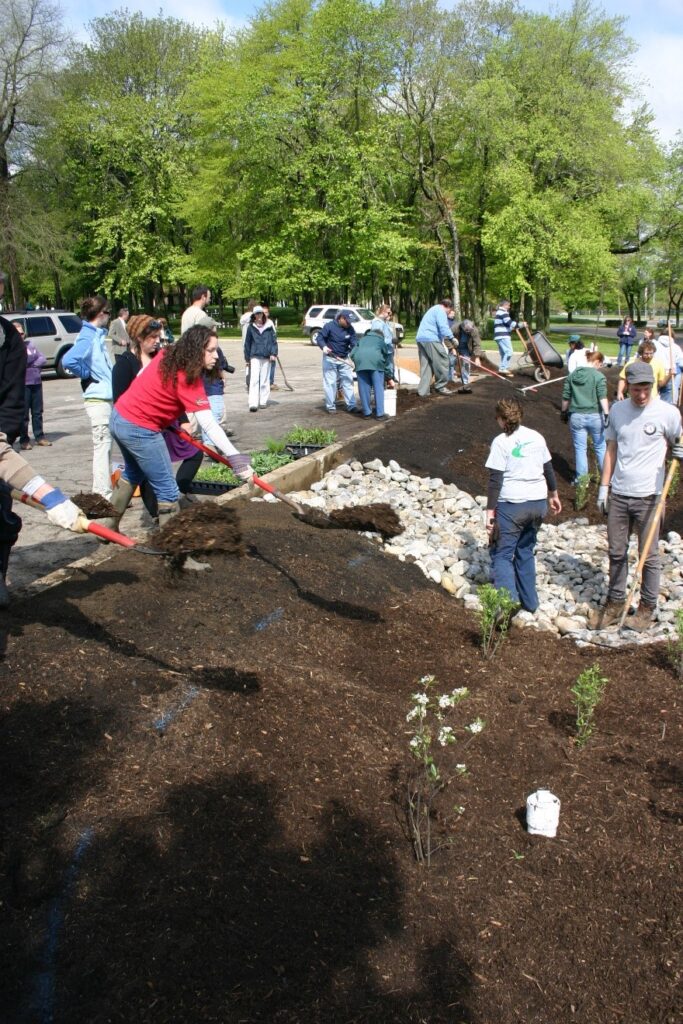
Installation of the rain garden at Thompson Park in 2010. Photo Credit: Michele Bakacs.
The first rain garden I helped install was Middlesex County’s Thompson Park rain garden in Monroe Township in April 2010. The picture above is the installation of the 700 square foot rain garden, and you can see me in the red shirt helping to spread mulch. At the time when this picture was taken, I did not know that I was pregnant with my first child. I’ve watched this rain garden grow and mature just like I’ve watched my son Benjamin, now 12 years old.
Just like children, rain gardens need care to function properly. The Thompson Park rain garden has been diligently cared for by the Middlesex County Parks and Recreation department. UN-like children, rain gardens do not need a lot of maintenance, but there are basic practices that must be done every year to ensure that rainwater infiltrates properly, sediment is removed, erosion and clogging is prevented, and plants are pruned and replaced if needed. Every year since installation the Parks Department has trained volunteers and county conservation corps staff on maintenance practices. Their efforts have paid off. The rain garden drains a 13,000 sq ft parking lot and in the 13 years since installation it has captured and filtered almost 5 million gallons of water.
Just like it takes a village to raise a child, it took many partners to implement this rain garden. It was designed and installed by Princeton Hydro, LLC and Middlesex Parks and Recreation, and installed as part of a Rutgers Rain Garden Certification Workshop which provided hands-on experience in rain garden installation. Funding came from the NJ Department of Environmental Protection and the project was led by the NJ Water Supply Authority and Middlesex Planning Department.
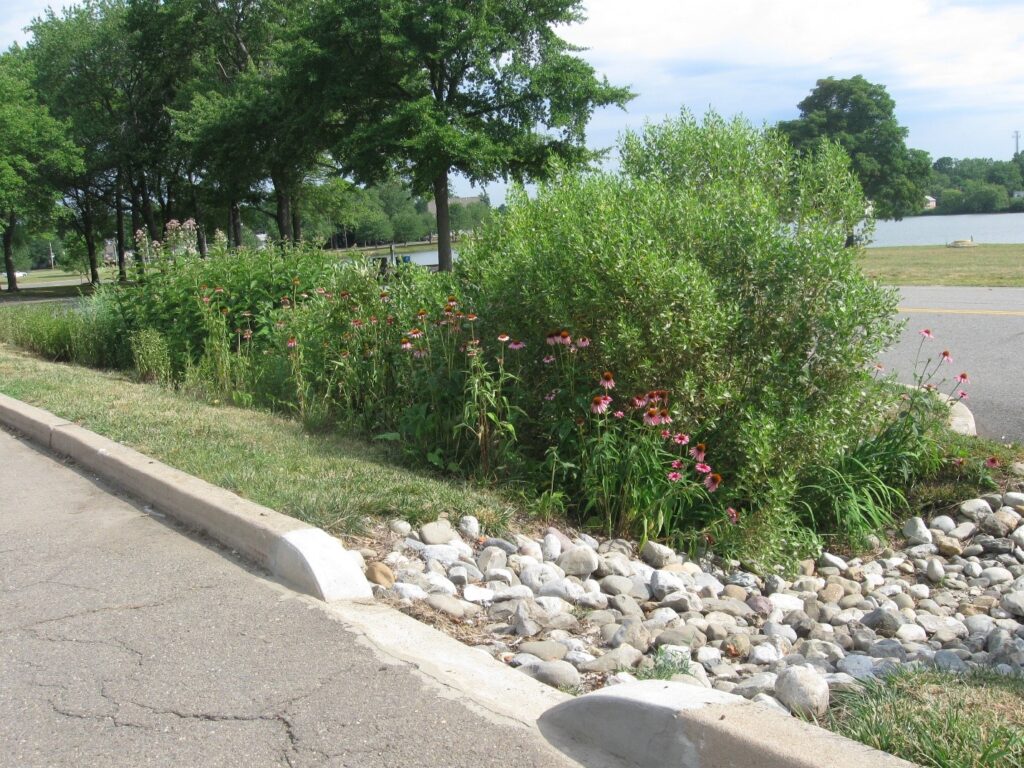
The completed rain garden at Thompson Park. Photo Credit: Michele Bakacs.
Much has changed with stormwater management since 2010. There are now untold numbers of rain gardens all over New Jersey. Green infrastructure is now mandated through New Jersey’s stormwater rules for major developments, and we have many resources to help communities implement these best practices including:
Resources
- Rutgers Cooperative Extension Rain Garden Manual. water.rutgers.edu/Rain_Gardens/RGWebsite/RainGardenManualofNJ.html
- Rutgers Green Infrastructure Champions Program. www.water.rutgers.edu/Projects/GreenInfrastructureChampions/GIC.html
- New Jersey Future’s Green Infrastructure Municipal Toolkit. gitoolkit.njfuture.org/
I am thankful for the countless volunteers who act as citizen scientists throughout the state
Steve Yergeau, Rutgers Cooperative Extension – Ocean & Atlantic Counties
Whether called citizen science, community science, people-powered science, or volunteer monitoring, it means trained individuals volunteering their time to assist with research and collecting important data. Many research projects involve the collection of large amounts of data that can only happen with the generous assistance of volunteers who donate their valuable time.
Not only does participation as a citizen scientist move research forward on a bigger scale by having more people involved, but it also educates individuals on the issues surrounding their chosen project. For example, many folks participate in beach clean-ups and count the trash they collect and see firsthand the impact of trash on coastal waters. Armed with this knowledge, the citizen scientists can look at their own waste practices to improve their recycling habits or start to compost their organic garbage.
There are so many exciting opportunities for volunteers to contribute to the collection of scientific data at home or in your community. And any interests, hobbies, or specific skills you may have, such as birding, kayaking, or stargazing, can be extremely prized on many projects! Check out any of the resources below for more information on opportunities that may interest you.
- ‘YOU Can Be a Citizen Scientist!’ Earth Day Every Day webinar. envirostewards.rutgers.edu/earth-day-every-day/
- Citizen Science Guide from Rutgers Libraries. libguides.rutgers.edu/citizenscience/getinvolved
- SciStarter website of citizen science projects across the country. scistarter.org/

Rutgers Master Gardeners collect compaction data on lawns to help determine soil health in Ocean County. Photo Credit: Steve Yergeau
I am thankful for the success of the New Jersey plastic bag ban
Amy Rowe, Rutgers Cooperative Extension – Essex & Passaic Counties
The measure also prevented restaurants from providing polystyrene foam containers for takeout and limited single-use plastic straws to customer requests only. The law has been in effect for a year and a half and preliminary numbers from the first year have estimated that more than 5.5 billion single-use plastic bags were kept out of the waste stream. Additionally, it is estimated that there was more than a 37% decrease in single-use plastics found as litter at the Jersey Shore. Finally, retail establishments purchased only 2 million straws per month down from 17 million per month prior to the law, an 88% reduction.
The full report from the Governor’s Plastics Advisory Council can be found at
dep.nj.gov/wp-content/uploads/pac-first-year-report-2023.pdf.
I’m thankful that New Jersey has been proactive in reducing litter and reducing our reliance on fossil fuel-based products like plastic bags, Styrofoam, and straws. This legislation is a great tool for cleaning up our environment and for helping keep New Jersey green!